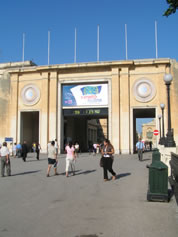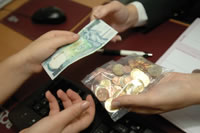

Navigation path
After Slovenia’s successful changeover to the euro on 1 January 2007, Malta and Cyprus followed on 1 January 2008, bringing euro-area membership to 15 EU countries and a population of around 320 million.
As small islands, Malta and Cyprus share similar economies: both have
limited natural resources, making them strongly import-dependent – especially
in goods and energy. This makes them more vulnerable to external shocks, such
as oil price hikes. However, throughout the 1990s and early 2000s, Malta and
Cyprus experienced significant economic growth. Their accession to the EU in
May 2004 and to the euro area in January 2008 is the logical way to anchor
their economic stability.
 Since their
accession to the EU, Malta and Cyprus have undertaken a remarkable fiscal
adjustment to achieve ‘sound’ and ‘sustainable’ public finances as required by
the Maastricht convergence criteria. Between 2003 and 2006, the budget deficit
fell from 6.3% of GDP to 1.5% in Cyprus, and from 10% to 2.6% in Malta. And
despite the upward trend in the years preceding EU accession, both countries
have significantly reduced their public debt since 2004.
Since their
accession to the EU, Malta and Cyprus have undertaken a remarkable fiscal
adjustment to achieve ‘sound’ and ‘sustainable’ public finances as required by
the Maastricht convergence criteria. Between 2003 and 2006, the budget deficit
fell from 6.3% of GDP to 1.5% in Cyprus, and from 10% to 2.6% in Malta. And
despite the upward trend in the years preceding EU accession, both countries
have significantly reduced their public debt since 2004.
The inflation and interest rate criteria have also been met. In March 2007 the
average inflation rate of the last 12 months was 2.0% in Cyprus and 2.2% in
Malta, both under the reference value of 3%. Long-term interest rates have also
fallen in recent years, to 4.2% (Cyprus) and 4.3% (Malta), below the reference
value of 6.4% in March 2007.
The Cypriot pound (CYP) and the Maltese lira (MTL) have participated in the
Exchange Rate Mechanism (ERM II) since 2 May 2005, thus meeting the criterion
on exchange rate stability.
This process of economic convergence culminated in the decision by the ECOFIN
Council on 10 July 2007, only three years after Cyprus and Malta joined the EU,
that both countries fulfilled the necessary conditions to join the euro area
from 1 January 2008. The ministers of finance of the EU also fixed the rate at
which the single currency will be adopted: CYP 0.585274 and MTL 0.429300 for
one euro.
The euro will continue to bring growth and stability to the two island states.
It will help preserve price stability, and will bring the benefit of the euro
area’s historically low interest rates. It will also reduce costs for
travellers, a major advantage for Malta and Cyprus which are important tourist
destinations. Trade will be given a boost by the elimination of transaction
costs and exchange rate risks – a great benefit for these two import- and
export-dependent economies, which will be now able to reap the full benefits of
the single market.
The government of Cyprus approved the designs for the national sides of euro
coins on 22 June 2006, chosen following an open competition and minted by the
Finnish Mint following a call for tenders. The designs show three national
motifs – the mouflon, the ship of Kyrenia, and the prehistoric idol of
Pomos.
>>View the national sides of Cyprus euro coins
On 13 October 2006 the Maltese Central Bank published the three winning designs for the national sides of the euro coins, following extensive public consultation via SMS. The mintage was contracted out to the Monnaie de Paris, the French mint. The designs are based on national symbols – the Maltese cross, the Maltese coat of arms and the prehistoric temple of Mnajdra.
>>View the national sides of Maltese euro coins
 Unlike the ‘first
wave’ euro-area members, Cyprus and Malta will put euro banknotes and coins
into circulation on the same day the euro becomes the country's official
currency. However, the Cyprus pound and the Maltese lira may still be used in
cash payments alongside the euro until 31 January 2008 – and it will still be
possible to exchange them for euros free of charge thereafter:
Unlike the ‘first
wave’ euro-area members, Cyprus and Malta will put euro banknotes and coins
into circulation on the same day the euro becomes the country's official
currency. However, the Cyprus pound and the Maltese lira may still be used in
cash payments alongside the euro until 31 January 2008 – and it will still be
possible to exchange them for euros free of charge thereafter:
A Commission report on the state of practical preparations, published in
November 2007, shows that Cyprus and Malta are well advanced in their
preparations to adopt the euro, and have made significant efforts in the past
few months by stepping up communication and launching a major cash supply
operation.
Cyprus faces a logistic challenge as about 335 credit institutions with
940 branches operate on the island. The supply of euro cash to commercial banks
(frontloading) began on 22 October 2007 for coins and 19 November for notes. In
turn, banks are providing the business sector, notably retailers, with euro
cash (sub-frontloading) so that they can give change only in euro starting from
€-day. Pre-packed euro-coin kits for business (starter-kits) and mini-kits for
the general public have also been available since 3 December 2007. Since
November 2007, some banks have also been exchanging Cyprus pounds into euros
free of charge.
On €-day, at least 70% of the 550 ATMs operated in Cyprus – including all
machines in central locations – are expected to dispense only euro banknotes by
01.00, and all of them by noon on the same day. They will only dispense €10 and
€20 banknotes initially, to help shops give change only in euros. On 1 January,
a public holiday, some bank branches will, exceptionally, open to allow people
to exchange cash.
Malta has a rather more concentrated financial sector structure, with
two credit institutions holding 90% of all bank accounts, and remains a largely
cash-based society. The Maltese authorities have taken a number of initiatives
to persuade citizens to deposit cash with banks before €-day rather than
hoarding it, including an intensive media campaign and an 'amnesty' regulation
allowing undeclared income to be registered until the end of July 2007.
 Practical
preparations in Malta started early, in 2006, and intensified after the summer
of 2007 with the launch of a new communication campaign, and the start of the
frontloading (mid-September) and sub-frontloading operations (beginning of
December). Starter-kits for businesses and mini-kits for citizens have also
been available since 10 December 2007.
Practical
preparations in Malta started early, in 2006, and intensified after the summer
of 2007 with the launch of a new communication campaign, and the start of the
frontloading (mid-September) and sub-frontloading operations (beginning of
December). Starter-kits for businesses and mini-kits for citizens have also
been available since 10 December 2007.
In Malta, 60% of the island's 154 ATMs – at least one in each major locality –
are expected to be dispensing euro banknotes from 00.00 on €-day. By noon, this
figure will be up to around 90% and by 16.00 100%.
Although support for the euro has been increasing over the last year in Cyprus
and Malta, the latest surveys conducted by the Commission show that many still
fear cheating and undue price rises during the changeover (74% of Cypriots and
65% of the Maltese).
To address these worries, and prevent price abuses, Cyprus and Malta have taken
a number of steps:
In Cyprus, about 7 130 companies have subscribed to the Fair Pricing
Code launched by the authorities last July. Five Euro Observatories and 90 euro
assistants are in place to monitor the dual display of prices –mandatory from 1
September 2007 until 30 September 2008 – and the respect of the Fair Pricing
Code, as well as to provide assistance to businesses and customers.
 Malta’s fair
pricing scheme, the FAIR initiative, has been in place since January 2007 and
now involves 80% of all retail outlets. This foresees administrative fines for
those failing to respect their commitment to apply correct dual display of
prices – mandatory from 11 July 2007 until 30 June 2008 – and not to exploit
the changeover for unfair gain. A Euro Observatory co-ordinates the FAIR
initiative and provides support to the retail sector through its 70 euro
assistants.
Malta’s fair
pricing scheme, the FAIR initiative, has been in place since January 2007 and
now involves 80% of all retail outlets. This foresees administrative fines for
those failing to respect their commitment to apply correct dual display of
prices – mandatory from 11 July 2007 until 30 June 2008 – and not to exploit
the changeover for unfair gain. A Euro Observatory co-ordinates the FAIR
initiative and provides support to the retail sector through its 70 euro
assistants.
Other measures are the PriceWatch initiative, consisting of regular price
monitoring of 400 frequently purchased products, Price Stability Agreements
with importers, distributors and manufacturers to 'freeze' prices of
fast-moving consumer goods between October 2007 and March 2008, and anonymous
'mystery shopping' exercises.
 >> Infoclip on the euro preparations in
Cyprus
>> Infoclip on the euro preparations in
Cyprus
 >> Infoclip on the euro preparations in
Malta
>> Infoclip on the euro preparations in
Malta
 In
Cyprus, the government communication strategy has since August 2007
focused on reaching those who remain sceptical about the euro, with a massive
presence in the broadcast and print media under the slogan 'The euro: it's in
your hands'. In the autumn, four 'eurobuses' travelled around the island to
provide information and answer questions, mostly in rural areas. And two new
campaigns involving Cyprus’s Olympic sports stars and the ancient myth of
Europa and the bull were launched shortly before Christmas.
In
Cyprus, the government communication strategy has since August 2007
focused on reaching those who remain sceptical about the euro, with a massive
presence in the broadcast and print media under the slogan 'The euro: it's in
your hands'. In the autumn, four 'eurobuses' travelled around the island to
provide information and answer questions, mostly in rural areas. And two new
campaigns involving Cyprus’s Olympic sports stars and the ancient myth of
Europa and the bull were launched shortly before Christmas.
>> View 'Europa and Taurus' poster![]() (177 kB)
(177 kB)
>> View Sport stars advertising campaign![]()
![]() >> View Sport
stars TV spot
>> View Sport
stars TV spot![]()
In Malta, a fully-fledged communication strategy was adopted already in
2006, with a particular focus on vulnerable groups and housewives. In September
2007, the National Euro Changeover Committee (NECC) revamped the campaign under
the slogan 'The euro, our money – Strengthening Malta in Europe'. Mainly a TV
and press campaign, it also incorporates special euro themes into one of
Malta's most popular sitcoms. Since May 2007, the monthly newspaper 'The euro
on your doorstep' has also been distributed to all Maltese households.
>>
'The euro on your doorstep'
>> View price stability advertising campaign![]() (374 kB)
(374 kB)
A 'cascade' communications scheme has been put in place to encourage citizens,
especially the elderly, to become ambassadors of the euro in their communities.
Furthermore, the Church authorities have been involved in the campaign via the
euro info centres open in all villages and towns since 1 December 2007.
The Commission has supported the communication efforts in both countries,
firstly by a partnership agreement concluded with Cyprus and Malta on 5 May
2006, under which it directly provides financial and technical assistance, and
secondly by the organisation of twinning programmes for transfer of know-how
and best practice regarding the euro changeover. Cyprus was twinned with
Greece, and Malta with Austria, and together they had a joint twinning scheme
in place with Ireland.
Additional tools